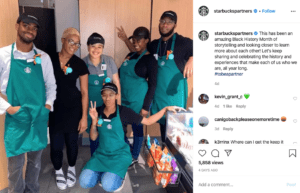
Starbucks baristas stand on stage, Wednesday, March 20, 2019, during Starbuck’s annual shareholders meeting in Seattle.
As a marketing team, your content library is your baby. You know it has the potential to not only attract potential buyers but to convert them as well. You’re writing blog posts, newsletters, email campaigns, creating photo and video content, but it’s not resonating with your audiences the way you thought it would. Well, could it be that you’ve given your marketing team too much control over this process?
One of the biggest challenges facing marketers and social media teams in 2020 is creating content at scale. In the age of social media and short attention spans, it’s simply not enough to have a presence on one social media platform – you have to be everywhere. Of course, we’re not suggesting the likes of HSBC and Barclays start promoting money-inspired dances on TikTok, but to have content on all company-relevant major social networks is something of a necessity.
The same content won’t resonate across all social channels, with each now serving a niche purpose. Instagram, for example, favors photo and video content, whereas LinkedIn is a much more corporate landscape that hosts more long-form, company-oriented content. With this in mind, you’ll need to create and maintain various content catalogs for social media use. A great way of doing this is creating short-form content from your macro content. For example, taking key takeaways from a study and turning them into Slideshows for LinkedIn’s Slideshare, or shortening them further and repurposing them as quote-stamped images for Instagram.
Useful as these may be, it can be time-consuming and, given the employee/crowdsourcing alternative, something of a waste of company time and resources. Most marketers and social media managers probably haven’t considered that their most authentic and cost-effective content creators are their employees. Whether you like it or not, your employees are already creating an abundance of company-relevant content. Granted, some may not be suitable for company use, but they are continually creating written content, making presentations, documenting life at the company, and posting to social media.
Not only are your employees creating content, but they’re reputable creators and ambassadors, too. After all, they are experts in both your company and industry alike. Here are five brilliant ways to get your employees creating and crowdsourcing content on behalf of your company.
Jump to:
- Use Company Hashtags
- Incentivize the Process
- Provide Ongoing Education
- Content Creation in Job Descriptions
- Employee Content Creation Tools
- Companies Using Employee Content Creators

Reebok employees share company-relevant content using a hashtag (image source).
1. Use Company Hashtags
Encouraging your employees to use company-specific hashtags is a great way to get them creating content.
Hashtags make it simple for content/social media managers to locate company-relevant content on social media. For example, if your company had an event coming up, you could create a unique hashtag for said event and encourage employees to use the hashtag when uploading to social media.
Though it should be said that this is a somewhat flawed process, and has led to one or two well-documented social media embarrassments after hashtags have been commandeered and abused by trolls. The issue lies in the fact that a hashtag is not private or gated by an organization, and so the public is free to highjack it if they please. Not only does this leave a company red-faced in the public eye, but it makes it particularly challenging to identify the content you were initially hoping for.

DSMN8 Employees submit content for company use (© DSMN8)
2. Incentivize the Process
Many of your employees will already be aware of the personal branding benefits that come with creating content for their employer. Still, it’s worth acknowledging and accepting that some employees may need that push to go the extra mile for their organization.
A fantastic tried-and-tested way of getting your employees to create content is by incentivizing the process. Incentivization can be achieved in any number of ways, though offering rewards for top submissions has shown to be an invaluable way of not only crowdsourcing employee-generated content but continuing the process for future use.
You can even go as far as creating leaderboards. Not only will participants want to be seen to be the top-performing employees due to the friendly competitive nature of a workplace, but they’ll also see this as an opportunity to elevate their personal brand among colleagues.

3. Provide Ongoing Education
Sure, you can ask your employees to share content using a particular hashtag, meaning you can easily track it. However, still, employees will remain apprehensive about creating content for their organization for fear of saying or doing the wrong thing on social media.
Having and communicating a clear and concise set of social media guidelines will relieve any apprehension your employees may have felt about sharing and creating content on behalf of your company. If you’re attempting to crowdsource high-quality, authentic content from your employees, then make sure they’re aware of just what they can create and share. No employee will want to shoot themselves in the foot, so to speak.
It’s one thing to make your employees aware of your social media guidelines, but this is little encouragement if they’re not aware of the benefits of creating or being credited for content that is to be posted by your organization. You’re probably aware of the personal branding benefits that come with advocating for your company/industry, but putting the theory into action in the form of industry/company relevant content is what truly separates the advocates from the industry thought leaders.
To ensure your employees create high-quality content, you could hold education and training events and seminars, during which you can introduce the latest strategies, highlight the many benefits of content creation, and introduce new technologies. If using a company Intranet, or an internal comms tool like DSMN8, perhaps consider utilizing this as it is a fantastic way of getting your message across.
Another reason your employees may not consider sharing and creating content for your company is because they lack the confidence and belief in themselves to post anything of value. It can be a daunting process to submit suggested content to your employer for fear of rejection, so ensure that you offer the necessary support and actively encourage them to submit something.
4. Highlight Content Creation in Job Descriptions
Large organizations seldom review their job descriptions before posting, but it may be time to revisit and start including content creation here and there. This is a great way to ensure your employees are aware of what is expected of them from the offset.
You may want to consider giving incentive pay in the form of bonuses, which can be tied in with a commission package. Not only will your employees create content because they believe it is expected, but they will also ensure it is of the highest standard if they’re to be rewarded with a commission if it converts.

5. Employee Content Creation Tools
Employee content creation tools are software that allow a company’s employees to create and submit content on behalf of their organization. They streamline the process of content submission and usage rights and allow employees to submit content that can later be approved for company use.
They can also be an invaluable tool to help control a brand’s messaging. One of the biggest issues with the previously mentioned content creation techniques is that once it’s posted, it’s available for the world to see. Of course, for information-sensitive industries like pharmaceuticals, this could be a stressful ordeal. Grunenthal is an example of an organization that were able to let go of any legacy fears of empowering employees, as they incorporated a platform that provided clarity for both employees and the company alike.
Most businesses rely on their social media community manager or agency partners to take pictures and videos, but of course, they can not be everywhere at once.
From an employee’s first day to team away day photos, leaning on your employees for photo and video content is a fantastic way to crowdsource company-based content for social media.
Of course, having a great blog is just as vital if your organization is to be seen and recognized as industry leaders. Creating written content at scale remains a challenge for organizations big and small. Why not encourage employees to write content?

Reebok employees using the #FitAssCompany (© Image by Stephanie Lemezza)
Companies Using Employee Content Creators
Reebok
Sportswear and fitness brand Reebok pioneered employee-generated content and turned their employees into content creators for their organization by use of the humble hashtag.
They began by approaching employees who they believed already had good social media awareness and were actively posting on the platforms they were targeting. When using the hashtag, they asked that employees only post content specific to the sports industries that the brand specializes in, such as cross-training and weight-lifting. Contrary to the familiar social media policies of large organizations, Reebok encouraged openness and authenticity from their employees.
The hashtag attracted the attention of employees’ followers, who will have come across similar subtly branded content upon searching the hashtag. It also proved useful for Reebok, as it allowed them to easily monitor the content that was being shared by employees.

Starbucks Partners Instagram (© Starbucks, image source)
Starbucks
The name of coffee titans Starbucks is often brought up in conversations of employee advocacy and employee content creation, and for a good reason. Starbucks has been utilizing the authentic power of its employees as content creators for some time now. The company refers to its employees as ‘Partners.’ Starbucks encouraged their employee content creators by creating specially made employee-led social media accounts, titled ‘Starbucks Partners.’ The accounts allow employees to post photos, start discussions, and interact with other employees.
Starbucks realized that employees weren’t sharing not because they didn’t want to, but they held reservations because they were uncertain of what they could and couldn’t share. The company issues employees with a list of guidelines, advising employees on how to operate when communicating on behalf of the brand, relieving any anxiety employees may otherwise have felt.
Starbucks’ willingness to allow and encourage their employees to create and share content is largely part of the reason their efforts are so successful.

Photo from Joe Lammerman on Instagram (© lammdogg_aviation)
United Airlines
United Airlines began building a team of in-house social media influencers when they realized one particular employee’s company content was already resonating with their audience.
United Airlines baggage-handler Joe Lammerman began documenting his day-to-day activities at United, offering his followers a behind-the-scenes look at what goes on at the company.
Instead of insisting Lammerman stop what he was doing, United instead made it part of his job to keep doing what he’d been doing. The airline quickly recognized the effect Lammerman’s content was having and saw that he already held a good amount of influence on social media.
United have not had to deal with any breaches of their social media policy through this initiative. Likely because the guidelines and policy itself have been clearly communicated and understood from the beginning.
Now you have the blueprint, the only thing left to do is get started.
Lewis Gray
Senior Marketing Manager and Employee Advocacy Program Manager at DSMN8. Lewis specialises in content strategy, growing brand visibility and generating inbound leads. His background in Sales lends itself well to demand generation in the B2B niche.


